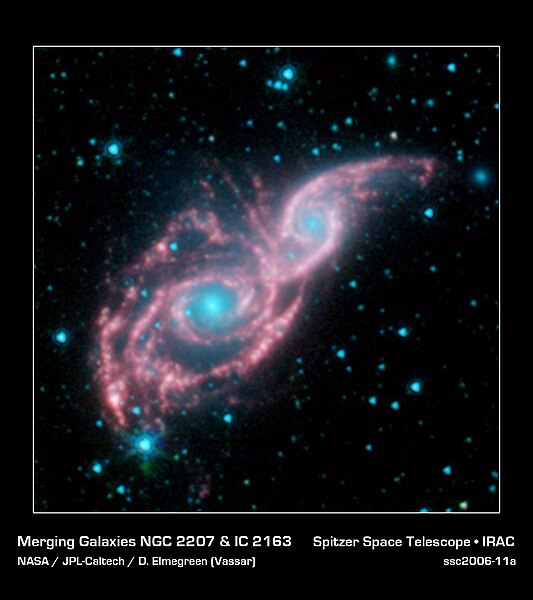File:Merging Galaxies NGC 2207 & IC 2163.jpg

Original file (1,200 × 1,350 pixels, file size: 527 KB, MIME type: image/jpeg)
Captions
Captions
Summary[edit]
Something appears to be peering through a shiny red mask, in this new false-colored image from NASA's Spitzer Space Telescope. The mysterious blue eyes are actually starlight from the cores of two merging galaxies, called NGC 2207 and IC 2163. The mask is the galaxies' dusty spiral arms.
NGC 2207 and IC 2163 recently met and began a sort of gravitational tango about 40 million years ago. The two galaxies are tugging at each other, stimulating new stars to form. Eventually, this cosmic ball will come to an end, when the galaxies meld into one. The dancing duo is located 140 million light-years away in the Canis Major constellation.
The Spitzer image reveals that the galactic mask is adorned with strings of pearl-like beads. These dusty clusters of newborn stars, called "beads on a string" by astronomers, appear as white balls throughout the arms of both galaxies. They were formed when the galaxies first interacted, forcing dust and gas to clump together into colonies of stars.
This type of beading has been seen before in other galaxies, but it took Spitzer's infrared eyes to identify them in NGC 2207 and IC 2163. Spitzer was able to see the beads because the stars inside heat up surrounding dust, which then radiates with infrared light.
The biggest bead lighting up the left side of the mask is also the densest. In fact, some of its central stars might have merged to form a black hole. (Now, that would be quite the Mardi Gras mask!)
This picture, taken by Spitzer's infrared array camera, is a four-channel composite. It shows light with wavelengths of 3.6 microns (blue); 4.5 microns (green); and 5.8 and 8.0 microns (red). The contribution from starlight (measured at 3.6 microns) has been subtracted from the 5.8- and 8-micron channels to enhance the visibility of the dust features.
File info[edit]
| DescriptionMerging Galaxies NGC 2207 & IC 2163.jpg | Ready for the Cosmic Ball |
| Date | |
| Source | http://gallery.spitzer.caltech.edu/Imagegallery/image.php?image_name=ssc2006-11a |
| Author | NASA/JPL-Caltech/D. Elmegreen (Vassar) |
| Permission (Reusing this file) |
http://www.spitzer.caltech.edu/Media/mediaimages/copyright.shtml |
Individual images[edit]
see http://gallery.spitzer.caltech.edu/Imagegallery/image.php?image_name=ssc2006-11a High quality tif files also avaliable.
Licensing[edit]
| Public domainPublic domainfalsefalse |
| This file is in the public domain in the United States because it was solely created by NASA. NASA copyright policy states that "NASA material is not protected by copyright unless noted". (See Template:PD-USGov, NASA copyright policy page or JPL Image Use Policy.) |  | |
 |
Warnings:
|
File history
Click on a date/time to view the file as it appeared at that time.
| Date/Time | Thumbnail | Dimensions | User | Comment | |
|---|---|---|---|---|---|
| current | 19:07, 11 July 2007 |  | 1,200 × 1,350 (527 KB) | Anzibanonzi (talk | contribs) | ==Summary== Something appears to be peering through a shiny red mask, in this new false-colored image from NASA's Spitzer Space Telescope. The mysterious blue eyes are actually starlight from the cores of two merging galaxies, called NGC 2207 and IC 2163. |
You cannot overwrite this file.
File usage on Commons
The following 2 pages use this file:
- File:Merging Galaxies NGC 207 & IC 2163.jpg (file redirect)
- File:Ssc2006-11a.jpg (file redirect)
File usage on other wikis
The following other wikis use this file:
- Usage on ru.wikipedia.org
- Usage on vi.wikipedia.org
Metadata
This file contains additional information such as Exif metadata which may have been added by the digital camera, scanner, or software program used to create or digitize it. If the file has been modified from its original state, some details such as the timestamp may not fully reflect those of the original file. The timestamp is only as accurate as the clock in the camera, and it may be completely wrong.
| Width | 1,200 px |
|---|---|
| Height | 1,350 px |
| Compression scheme | LZW |
| Pixel composition | RGB |
| Orientation | Normal |
| Number of components | 3 |
| Horizontal resolution | 300 dpi |
| Vertical resolution | 300 dpi |
| Data arrangement | chunky format |
| Software used | Adobe Photoshop CS2 Macintosh |
| File change date and time | 08:54, 26 April 2006 |
| Color space | Uncalibrated |